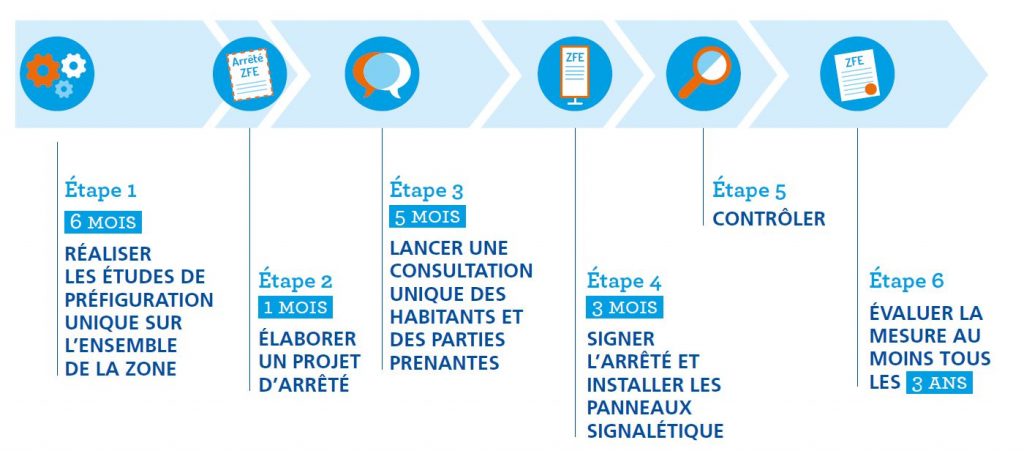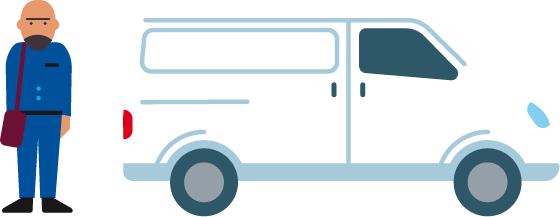



The Greater Paris Metropolis must respond to a health and climate emergency. Airparif, the Approved Association for Air Quality Monitoring (AASQA) in Île-de-France, estimates that in 2022, 40,000 metropolitan inhabitants breathed highly polluted air, which repeatedly exceeds the annual limit value for nitrogen dioxide (NO2). Santé Publique France estimates that 6,900 premature deaths could be avoided every year in the Metropolis by meeting the WHO guidelines on air quality. On 24 October 2019, France was condemned by the Court of Justice of the European Union (CJEU) for exceeding the annual limit value for nitrogen dioxide (NO2). On 4 August 2021, the Conseil d’Etat ordered the State to pay a penalty payment of €10 million for the first half of 2021, considering that it had not taken the necessary measures to enforce the European air pollution limit values in several urban areas, including Paris. The Conseil d’Etat renewed this sentence on 17 October 2022, and then on 28 November 2023.
The Greater Paris Metropolis has validated a metropolitan strategy with the Metropolitan Climate Air Energy Plan, definitively adopted by the Metropolitan Council on 12 November 2018. The improvement of air quality is one of its priorities. To achieve this, the implementation of a metropolitan low emission zone (LEZ) has been assessed, in the Île-de-France Atmosphere Protection Plan, as having the greatest ability to rapidly improve air quality.
This measure aims to accelerate the gradual phase-out of the most polluting vehicles, building on the financial aid scheme of the Greater Paris Metropolis. It is part of a broader metropolitan policy in favor of clean mobility, which also includes walking, cycling and more. And its benefits extend far beyond that, improving the quality of life, making the territory more attractive and reducing noise pollution as well. Other actions are also being taken against other sources of pollutants.
It is a scheme, endorsed by the State, intended to reduce pollutant emissions, particularly in large cities, to improve air quality and guarantee that residents can breathe air that is not harmful to their health. Already adopted by 315 European cities or metropolises, it is recognized as particularly effective in reducing pollutant emissions from road traffic, which is one of the main sources of pollution in cities.
Discover the expected health benefits of the LEZ according to the Regional Health Observatory.
Its principle: limiting the circulation of the most polluting vehicles within a defined perimeter, by decision of the President of the Greater Paris Metropolis. To drive within the LEZ, a Crit’Air sticker must be affixed to the windscreen. It allows to distinguish vehicles according to their level of air pollutant emissions. The most polluting vehicles and the “unclassified” ones are not able to drive within the LEZ during certain time slots (except for exempted ones).
The city of Paris put in place this type of measure in 2015, which covered Paris intra-muros, excluding the ring road and woods, and which concerned Crit’Air 4 and unclassified vehicles. But air pollution knows no borders: the goal of the metropolitan LEZ is to extend the perimeter, to coordinate and accelerate the ongoing process to obtain significant benefits throughout the metropolitan territory and beyond.
See the municipalities concerned by the Low Emission Zone.








Crit’Air stickers indicate the level of pollution associated with the vehicle. The higher the certificate number, the more pollutants the vehicle emits.
 |
 |
 |
 |
 |
 |
The “unclassified” vehicles are the oldest ones (registered before 1997), that do not have a Crit’Air sticker and therefore do not fall within the classification. The Crit’Air sticker, valid for the entire life of the vehicle, is issued based on the information present on the vehicle registration document (engine, age of the vehicle, etc.). Since 1 June 2021, the driving bans have applied to non-classified, Crit’Air 5 and Crit’Air 4 vehicles, which concern:
Warning : some fraudulent websites offer Crit’Air stickers that are not approved!

| New car (electric) | €24,000 |
|---|---|
| Remaining expenses | 2 000€ |
| Greater Paris Metropolis | €6,000 |
| Conversion bonus | €6,000 |
| Ecological bonus | €7,000 |
| LEZ bonus | €3,000 |

| New family car (electric) | €30,800 |
|---|---|
| Remaining expenses | €18,300 |
| Greater Paris Metropolis | €3,000 |
| Conversion bonus | €2,500 |
| Ecological bonus | €6,000 |
| LEZ bonus | €1,000 |

| New van (Electric) | €29,000 |
|---|---|
| Remaining expenses | €16,500 |
| Aid from the Region or the City of Paris | €29,000 |
| Conversion bonus | €2,500 |
| Ecological bonus | €4,000 |
How to get a Crit’Air sticker ? To obtain your “Air Quality Certificate”, in other words your “Crit’Air” sticker, it’s very simple: all you need to do is go to the following website : www.certificat-air.gouv.fr, with your vehicle registration document. A written procedure is also available by completing this form and returning it by post. Prepared on request, the certificate will be issued by post, on an individual basis, to each vehicle owner who requests it. It will be sent to the address shown on the vehicle registration document. This document must be affixed to your windscreen to attest to the environmental class of the vehicle according to its pollutant emissions. The certificate is a secure document that helps limit all types of fraud. The vehicle classification is valid for the entire life of the vehicle. The cost of the certificate is €3.77, payable online. This price covers the costs of manufacturing, managing and sending the certificate. It will take a few days for it to be manufactured and sent by mail. Once the order has been validated, the applicant will receive an email receipt attesting to the category of their certificate, while waiting to receive their certificate in the mailbox. This document is mandatory to drive in a low emission zone and voluntary everywhere else. Caution : Private websites (with no link to the Ministry of Ecological and Inclusive Transition) offer the Crit’Air sticker at a price much higher than the real price. Make sure you’re on www.developpement-durable.gouv.fr/certificats-qualite-lair-critair. Please note: all vehicles eligible for the Crit’Air sticker must display one in the areas concerned by it, including foreign vehicles. The sticker is linked to the vehicle, not to its driver.
FermerFailure to comply with the restrictions of a Low Emission Zone, or those provided for by differentiated traffic during pollution episodes, is punishable by a fourth class fine (€135 flat-rate), for heavy goods vehicles, buses and coaches, and third-class fine (€68 flat-rate), for other categories of vehicles. The following actions are thus sanctioned: driving in violation of the restrictions of a LEZ, parking in a LEZ without having a Crit’Air sticker (except for “unclassified” vehicles registered before 1997), affixing a Crit’Air sticker that does not correspond to the characteristics of the vehicle (4th class fine). To allow residents, businesses and communities to get organized, in principle, no sanctions are currently applied in the metropolitan LEZ, except in Paris and during pollution alerts. Until then, only pedagogical checks are carried out. However, road users must in all cases (even if they have an exemption) be in possession of the Crit’Air sticker within the LEZ. Otherwise, they are liable to a fine during a physical check.
FermerNational derogations
They are listed in Article R. 2213-1-0-1 of the General Code of Local Authorities:
-> Priority vehicles of general interest (defined in 6.5 of Article R. 311-1).
These are vehicles of the police, customs, ffirefighting mobile hospital units or, at the request of the emergency medical aid service, assigned exclusively to the intervention of these units and the Ministry of Justice for the transport of prisoners or the restoration of order in prisons;
-> Vehicles of general interest benefiting from passage facilities (6.6 of Article R. 311-1).
These include ambulances for medical transport, security intervention vehicles for companies managing electricity and gas infrastructures, the surveillance department of the French National Railway Company, cash transport vehicles for the Banque de France, medical associations contributing to the permanence of care, doctors when they participate in the departmental guard, transport of blood products and human organs, winter service equipment and, on motorways or roads with two separate carriageways, intervention vehicles of the services managing these roads;
-> Ministry of Defence vehicles;
-> Vehicles bearing a parking card for disabled persons or a “mobility inclusion” card bearing the mention “parking” provided for in Articles L.241-3 or L. 241-3-2 of the Code of Social Action and Families;
-> Low-emission public passenger transport vehicles within the meaning of Article L. 224-8 of the Environmental Code.
-> Public transport vehicles, within the meaning of Article R. 311-1 of the Highway Code, providing a regular public transport service that are included in one of the classes defined by the decree establishing the nomenclature of vehicles classified according to their level of emission of atmospheric pollutants, adopted pursuant to II of Article R. 318-2 of the same code, when that class is subject to a partial or total ban on movement in the area in question, for a period of between three and five years following the date on which that ban came into force. The period during which an exception to the driving ban is made may vary according to the categories of vehicles, with the least polluting vehicles being able to benefit from longer exceptions. It is determined by a joint order of the Ministers for the Environment and Transport.
Local derogations
-> Vehicles assigned to approved civil security associations, as part of their missions, with a document provided by the association proving their status;
-> Vehicles of charitable associations whose activities aim to contribute to the improvement of the living conditions of people in precarious or difficult situations;
-> Vehicles assigned to a public service, as part of one-off interventions, with a mission order from the competent authority;
-> Vehicles whose use is related to the following events or activities, with an authorisation from the municipality of Ile-de-France concerned by the event or activity, and within the exclusive framework of the event:
-> Vehicles of professionals carrying out removal operations,
vehicles used in the context of events or public highway demonstrations of a festive, economic, sporting or cultural nature,
-> Vehicles used in filming,
-> Market supply vehicles.
-> Refrigerated vehicles whose registration certificate bears the mention FG TD;
-> Tankers whose registration certificate bears the words CIT or CARB;
-> Specialised vehicles not used for the transport of goods as defined in Annex 5 of the above-mentioned Decree of 9 February 2009, bearing the mention VASP on the registration certificate or VTSU on the vehicle registration document, except for motorhomes;
-> Exceptional convoys within the meaning of Article R433-1 of the Highway Code with a prefectural authorisation;
-> Vehicles whose registration certificate bears the mention “collection”;
-> Vehicles over 30 years old used in the context of a commercial activity of a tourist nature, bearing the K-Bis of the company detailing this activity.
No individual action is required if you are in one of the categories of derogations listed in the question “Will there be derogations?” or in the “Exemptions for professionals” section.
All you need is proof of belonging to one of these categories of exemptions, to be presented in the event of an inspection.
Thus, no specific procedure at the town hall or with the Greater Paris Metropolis is necessary.
Pending the implementation of the automated sanction control, if your vehicle is affected by a derogation (see the question “Will there be exemptions”), you must bring proof mentioned in the LEZ municipal by-law (e.g. the registration certificate bearing the mention “collection”), in order to be able to present it in the event of an inspection.
FermerAs part of the national derogations integrated into the LEZ decrees, there is an exemption for vehicles displaying a mobility inclusion card with the words “parking for disabled people” or “a parking card for disabled people”.
These supporting documents alone are sufficient, in the event of an inspection.
Fermer<p>Under the current LEZ decree, vehicles with the “collection” mention on the registration document benefit from an exemption. For the time being, this is a local and not a national derogation.</p>
FermerThe exemptions for professionals are indicated in the answer to the question “Are there exemptions?”. Derogations are questioned at each stage of the LEZ and may therefore evolve according to the stages of reinforcement of the measure and according to the methods that will be implemented for the control of sanctions.
FermerTo support residents wishing to renew their vehicle, in addition to financial aid (see questions “What aid is available to individuals”; “What aid is available for businesses”), information sites and simulators to help you make choices and provide all the information on available financial aid are accessible from the links below. In addition, AVERE France, the national association for the development of electric mobility, representing the entire French electric mobility sector, has set up an electric vehicle portal to support individuals and companies who have questions before opting for this type of engine. AVERE, supported by the State and the Metropolis, among others, is responsible for the creation of this portal and its animation:
-> State information website: I change my car: https://jechangemavoiture.gouv.fr/jcmv/
-> One-stop shop: Conversion bonus: primealaconversion.gouv.fr
-> Avere website France: I drive an electric vehicle: je-roule-en-electrique.fr/
-> Metropolis website, pages dedicated to “Métropole Roule Propre!” : https://www.metropolegrandparis.fr/fr/metropoleroulepropre
77 municipalities within the perimeter of the A86 (excluding the A86) have the regulatory obligation to establish a Low Emission Zone on their territory. Find the map of the perimeter of the LEZ on the web page dedicated to the LEZ: www.zonefaiblesemissionsmetropolitaine.fr.
It should be noted that for the next provisional stages of strengthening the LEZ and depending on the evolution of the situation (environmental, regulatory, local, cyclical, etc.), the perimeter could change. Each new stage is also subject to prior impact studies and must be approved by the metropolitan council.
FermerThere are multiple schemes available to help individuals renew their vehicles. They can be added to each other and can be used to purchase new or used vehicles. They can reach up to €22,000 for a new vehicle and up to €16,000 for a used vehicle. These subsidies are reinforced according to the household’s income, and they are conditional on the scrapping of an old polluting vehicle.
As part of the implementation of the metropolitan LEZ, the French State and the Metropolis have set up a one-stop shop (www.primealaconversion.gouv.fr – telephone assistance, free service and call on 0800 74 74 00). Individuals can test their eligibility and submit a single application for the conversion bonus offered by the State and the “Métropole Roule Propre!” scheme offered by the Métropole du Grand Paris.
-> Find all the information on the “Métropole Roule Propre!” Scheme : metropolegrandparis.fr/fr/metropoleroulepropre
-> Find all the information on State aid: Conversion bonus, ecological bonus, ZFE surcharge, and since 2021, the 50% state-guaranteed microcredit for clean vehicles, which can be combined with financial aid for the renewal of a vehicle. Visit the information website: https://jechangemavoiture.gouv.fr/jcmv/
-> Find all the information on aid from the Ile-de-France region: www.iledefrance.fr/remplacement-des-voitures-des-particuliers-par-des-vehicules-propres
-> Other local aid exists, such as those offered by the EPT Paris Ouest La Défense, the City of Paris and the City of Drancy, find out more from your town hall
FermerProfessionals can apply for financial aid for the purchase or the long-term rental of clean vehicles, under certain conditions:
-> State aid: Conversion bonus, Ecological bonus. Visit the information website: https://jechangemavoiture.gouv.fr/jcmv/
-> Aid from the City of Paris: paris.fr/pages/lutte-contre-la-pollution-les-aides-a-la-mobilite-5373
Aid from the Île-de-France Region: iledefrance.fr/acquisition-de-vehicules-propres-par-les-professionnels-franciliens
The A86 motorway is not included in the LEZ scheme and thus allows the free movement of vehicles around the perimeter of the metropolitan LEZ.
FermerThe technical inspection is a national periodic diagnosis that aims above all to ensure the safety of vehicles and their occupants. Pollution-related controls only measure the level of carbon monoxide and the opacity of the fumes, and they do not provide precise information on the levels of nitrogen oxide or fine particles pollution, which particularly concern large urban areas.
FermerTraffic restriction hours apply to:
-> Heavy goods vehicles, buses, coaches: 7 days a week; from 8 a.m. to 8 p.m.;
-> Private vehicles; light commercial vehicles; Motorized two-wheelers, tricycles and quadricycles: Monday to Friday from 8 a.m. to 8 p.m., except on public holidays
FermerThe vehicles affected by the traffic restriction measures are:
-> Heavy goods vehicles,
-> Buses,
-> Coaches,
-> Private vehicles,
-> Light commercial vehicles,
-> Motorized two-wheelers, tricycles and quadricycles.
FermerThe metropolitan LEZ applies to vehicles from other French regions as well as from abroad. To drive in the metropolitan LEZ (as in other French low-emission zones), the Crit’Air sticker is therefore mandatory (refer to the question “How to obtain a Crit’Air sticker?”).
It should be noted that as of January 1, 2023, eleven French agglomerations have already established a LEZ, while 31 other agglomerations have made commitments to create one
On the other hand, many LEZs are being developed in Europe (Germany, the Netherlands, Spain, etc.) and elsewhere in the world (Japan, Mexico, etc.).
The Crit’Air sticker (air quality certificate) introduced in France in 2016, allows vehicles to be classified into 6 categories according to their air pollutant emissions. Older vehicles that fall under the least stringent emission standards are not eligible for a certificate. The higher the number on the sticker, the more polluting the vehicle is. The classification is valid for the life of the vehicle and concerns any type of motor road vehicle.
The Crit’Air sticker is mandatory to drive in low emission zones or to drive when the prefect introduces differentiated traffic in the event of pollution episodes.
For more information, please visit the dedicated Frequently Asked Questions on the website of the Ministry of Ecological Transition and Territorial Cohesion: www.certificat-air.gouv.fr/foire-aux-questions
To find out the Crit’Air classification of your vehicle, go to the simulator of the air quality certificate issuing service, on the above-mentioned Ministry’s website: www.certificat-air.gouv.fr/simulation
FermerGo to the simulator of the air quality certificate issuing service, on the website of the Ministry of Ecological Transition: www.certificat-air.gouv.fr/simulation.
FermerIf you live in one of the municipalities located within the perimeter of the A86 motorway (see map on the website dedicated to the metropolitan LEZ), consult the map of the municipalities involved or contact your town hall to find out if it has set up the LEZ on its territory. Indeed, until now, the implementation of a LEZ was the responsibility of the mayors’ police powers and resulted in the issuance of a police order. Thus, the metropolitan LEZ is currently made up of as many LEZ decrees as there are municipalities concerned. Starting from the 1 January 2025, a single decree will be issued by the President of the Greater Paris Metropolis for the 77 municipalities concerned.
Fermer